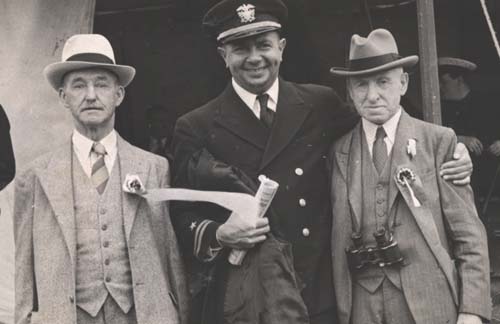World War II
In 1939, the unthinkable happened. Europe was once again involved in a war that would have Newfoundlanders join their British brethren on the field of combat. Following the tradition set during World War One, the Regatta of 1940 was cancelled as the people of Newfoundland did not feel this was a time for celebration.
There were American and Canadian servicemen stationed in Newfoundland during World War II. These young men had to make many adjustments to the island lifestyle of Newfoundland and the Newfoundlanders were impressed with them. One of the traditions the mainlanders had taken to was boat racing on Quidi Vidi Lake.

US Navy Officer Lt. H.R. Welsford with Regatta Committee Members
(Year: 1943, Source: Regatta Museum). |
After much discussion, it was
in the spirit of friendly competition and physical fitness that the races would continue
in 1941. Lieutenant Colonel Bruton was more then eager to
grant a holiday for the hard working servicemen in his charge. This was the first of the
War Time Regattas that lasted during the Canadian and American
stay in Newfoundland. It did well on two fronts: first, to provide a form of physical
activity for the men while providing sport and competition between the services, and second,
to provide a distraction from the war raging in Europe.
|
Regatta greats pass away
1943 saw the death of one of the most renowned figures in Regatta history. The Honourable William J. Higgins was best known for his involvement with the Regatta Committee and served as President of the committee from 1926 to 1928. Even when not actively involved he supported and promoted the Regatta with great enthusiasm. He rowed on the pond from 1901 to 1908, and participated in various other sports as well. The Honourable Mr. Higgins was a politician, lawyer and judge of the Supreme Court of Newfoundland, and was known for being even handed and fair. His impact on the Regatta was certainly positive and can still be felt today.
In 1944, there was a death of another significant figure in the Regatta, Mr. Bob Sexton. He was the builder of many famous boats such as Blue Peter, Red Lion, Nellie R, Pinkun, Hornet, Cadet, Star of the Sea, Guard, Bob Sexton and Mary. Mr. Sexton passed away peacefully at his residence on July 1st, 1944.
Following the grand tradition laid out after the First World War, the Regatta of 1945 was dubbed the Victory Regatta because it was held after the hostilities in Europe had ceased. Thousands of people came out to enjoy the spectacle that was the Regatta of 1945. The day was overcast and dull and actually had to be postponed for a short period while a brisk wind died down. As with the previous "War Regattas", this was held with crews from American, Canadian, British and Newfoundland services competing against one another.
From a Country to a Province
The final milestone of this era came in 1949, when Newfoundland joined Canadian Confederation and became a Province. During this Regatta, women competed in the regular schedule of events for the first time since 1856. Since 1949, female crews have come to outnumber male crews. Oddly, there is very little signifigance attached to the fact that Confederation with Canada took place this year, and in no way is the Regatta referred to as the Confederation Regatta. This may be a sign of the times as many Newfoundlanders were not happy with the idea of Confederation with Canada.
After 1949, the coming Regattas would never be the same.





